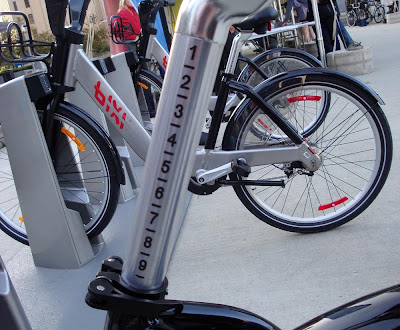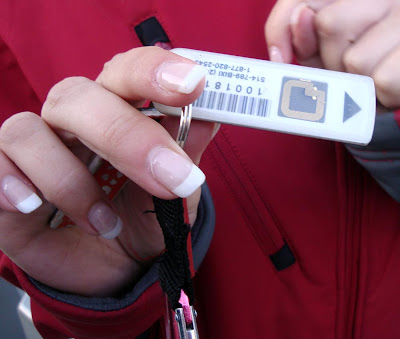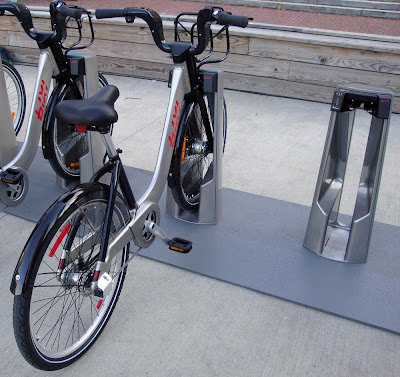
At the Mayor's Cup criterium race I got to try Bixi bikes, the bikes currently proposed for the Boston Bike Share program. Having just returned from France I can't help but compare them to the Velibs. They do compare favorably, holding their own, different but as good. Velib has less obvious branding on the bike itself, and more plastic, making it "cuter". Bixi has some qualities of its own which I will outline below.
 The basket system is less obvious than Velib's, but perfectly functional. It's two bars with a set of pegs on which you strap an elastic band in myriad permutations depending on your needs. My purse did not shift at all on my test ride.
The basket system is less obvious than Velib's, but perfectly functional. It's two bars with a set of pegs on which you strap an elastic band in myriad permutations depending on your needs. My purse did not shift at all on my test ride.The distance from the handlebars to the seat was much greater than Velib. I'm 5'8" and I felt the Velib was somewhat compact for me, however I felt that I was stretching to reach for the Bixi handlebars. These bikes are North American-sized! My 6' dad will love it, my 5' mother-in-law will not.
 The measured seatpost - what a brilliant idea! Once you know your Bixi seatpost height you can set it easily each time you pick up a bike.
The measured seatpost - what a brilliant idea! Once you know your Bixi seatpost height you can set it easily each time you pick up a bike. The integrated tail lights are a nice design point, though they may be too low to the road. At least they appear robust. The front wheel has the same Shimano dynamo hub as is used in all the French bike shares, I don't know much about this rear hub.
The integrated tail lights are a nice design point, though they may be too low to the road. At least they appear robust. The front wheel has the same Shimano dynamo hub as is used in all the French bike shares, I don't know much about this rear hub. Here is the access point for your bike. You insert your key and when you get the green light you pull your bike to remove it.
Here is the access point for your bike. You insert your key and when you get the green light you pull your bike to remove it.
This is the key that you would insert into the access box to check out your bike. It's larger than Velib's proximity card, but not too large. Is it a more reliable system? I don't know. I don't think the Bixi agent knew that her manicure was going to end up on the internet!
 Here's the bike station. They say they can set these up in 20 minutes, and could thus move more at a moment's notice to, say, Fenway if needed. Though I'd be pretty bummed if my favorite station suddenly disappeared. We will need an application for the iPhone like they have in Paris, giving real-time status updates for the nearby stations.
Here's the bike station. They say they can set these up in 20 minutes, and could thus move more at a moment's notice to, say, Fenway if needed. Though I'd be pretty bummed if my favorite station suddenly disappeared. We will need an application for the iPhone like they have in Paris, giving real-time status updates for the nearby stations. This triangle-shaped piece is what locks into the station. You roll the bike in between the upright bars in one fluid motion (3 points for your field goal!), and there are pins that then lock around the triangle. This is a *much* more robust system than Velib where a bent locking piece had us looking for a crowbar just to be able to return the bike. You can see in this photo that they don't use the Schwalbe Marathon tires used across France, it is some sort of generic.
This triangle-shaped piece is what locks into the station. You roll the bike in between the upright bars in one fluid motion (3 points for your field goal!), and there are pins that then lock around the triangle. This is a *much* more robust system than Velib where a bent locking piece had us looking for a crowbar just to be able to return the bike. You can see in this photo that they don't use the Schwalbe Marathon tires used across France, it is some sort of generic.My overall impression was of a true North American bike - less chic, more practical than her Parisian sister, and still something fun to ride. A subscription would cost $70-$80/year and I would happily pay that for access to these Bixi bikes, assuming I had access to stations where I need them.


















































